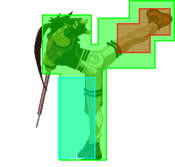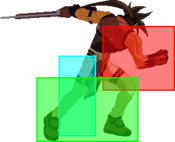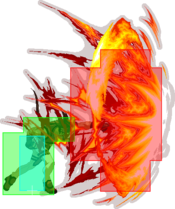Volcanic Viper
623S/H or j.623S/H
Go to sleep
Normal Versions:
S: 1st hit (Frames 7-9)
H: 1st hit (Frames 5-6)
j.S/H: 1st hit (Frames 5-6)
S: 2nd hit (Frames 13-23)
j.S: 2nd hit (Frames 10-18)
H/j.H: 2nd hit (Frames 10-27)
- Dragon Install Version
Dragon Install Versions:
DI All: 1st hit (Frames 7-9)
DI S: 2nd/3rd hit (Frames 11-16)
DI j.S/H: 2nd/3rd hit (Frames 12-19)
DI H: 2nd hit (Frames 10-63)
|
| Version
|
Damage
|
Guard
|
Cancel
|
Startup
|
Active
|
Recovery
|
Frame Adv.
|
| Ground Normal S
|
40,25
|
Mid
|
R
|
7
|
3(3)11
|
21+8L
|
-26
|
At neutral, Ground S Volcanic Viper (SVV) can be used at range to counter an opponent’s poke into a knockdown, but it is risky and will only be effective on attacks that extend their hurtbox. It can be used as an invulnerable reversal, but is slower than Ground H Volcanic Viper (HVV) and has a much thinner hitbox. It is not as unsafe as HVV, but still easily punishable.
- 1~9 Full invul
- 10~11F Strike invul
- 10F onwards airborne
- Floats opponent on hit (1st hit untechable on ground hit for 28F, 2nd hit untechable for 26F)
- 29F onwards can cancel into followup
- Sol is in crouching state during landing recovery
|
| Aerial Normal S
|
32,20
|
All
|
R
|
5
|
2(3)9
|
Until L+8
|
-
|
Aerial S Volcanic Viper (j.SVV) can be used as an anti-anti-air. Note that its hurtbox reaches much lower than that of Aerial H Volcanic Viper (j.HVV). It can also be used to counter aerial attacks at close range. j.SVV is used frequently to end air combos with knockdown via Knockdown (214K).
1~9 Strike invul
- Floats opponent on hit (1st hit untechable on ground hit for 36F, 2nd hit untechable for 27F)
- 24F onwards can cancel into followup
- Sol is in crouching state during landing recovery
|
| Normal H
|
40,25
|
Mid
|
R
|
5
|
2(3)18
|
30+8L
|
-41
|
Ground H Volcanic Viper (HVV) is Sol’s strongest defensive tool, and has applications for neutral and offense as well. It has fast start-up and is invulnerable instantly, so it can be used on wake-up or at any gap in the opponent’s pressure to counter their attacks. However, it is highly unsafe on block or whiff. Having Roman Cancel (RC) available removes much of the risk associated with it, allowing combos on hit or pressure if it is blocked. Dashing HVV is a strong but risky method of breaking through an opponent’s attempts to keep you out with pokes, and is especially good while the opponent is in mid-air. HVV is a strong anti-air option that can only fail if the opponent uses Faultless Defense or dodges it somehow. It is particularly useful for punishing forward air dashes, since the opponent must wait until the air dash is complete to Faultless Defense. On offense, HVV can be used as a frame trap and anti-throw option.
- 1~6 Full invul
- 7~11F Strike invul
- 7F onwards airborne
- Floats opponent on hit (1st hit untechable on ground hit for 28F, 2nd hit untechable for 36F)
- Knocks down opponent if 2rd hit was CH
- 33F onwards can cancel into followup
- Sol is in crouching state during landing recovery
|
| Aerial Normal H
|
40,20
|
All
|
R
|
5
|
2(3)18
|
Until L+8
|
-
|
Like Aerial S Volcanic Viper (j.SVV), Aerial H Volcanic Viper (j.HVV) can counter aerial attacks, and can be used to end air combos with knockdown via Knockdown. j.HVV reaches much higher than its S counterpart, so it can be used from farther away. While j.HVV has higher base damage than j.SVV, you need to be closer to land both hits, so which version you go for in combos will ultimately depend on positioning.
- 1~9 Strike invul
- Floats opponent on hit (1st hit untechable on ground hit for 38F, 2nd hit untechable for 36F)
- 33F onwards can cancel into followup
- Sol is in crouching state during landing recovery
|
| Dragon Install S
|
40,20*2
|
Mid
|
R
|
7
|
3(1)4,2
|
21+8L
|
-17
|
The Dragon Install (DI) version of Ground S Volcanic Viper (SVV) is used in much the same way as a regular SVV. The additional hit increases combo damage and decreases disadvantage on block, although not enough to prevent it from being highly punishable. That being said, (DI) SVV doesn't see much use during DI, due to the far higher reward on the H versions.
- 1~9 Full invul
- 10F Strike invul
- 10F onwards airborne
- Floats opponent on hit (1st hit untechable on ground hit for 28F, 2nd/3rd hit untechable for 30F)
- Knocks down opponent if 3rd hit was CH. Sol is in crouching state during landing recovery
|
| Dragon Install H
|
40,18*9
|
Mid
|
R
|
7
|
3,54
|
36+8L
|
-76
|
In Dragon Install (DI), Ground H Volcanic Viper (HVV) boasts greatly enhanced firepower. Dealing a total of 10 hits, connecting with either version results in a large amount of damage, especially if it hits raw. With all 9 rising hits building a base 7.2% Tension on hit, (DI) HSVV has the highest Tension Gain of any attack in the game. Of course, the move is not without its weaknesses. It is massively unsafe on block or whiff, putting Sol at a greater disadvantage than any other attack he has. For that reason, you should never go for a (DI) HVV in unconfirmable situations without the necessary 50% Tension required to RC.
- 1~9 Strike invul
- Floats opponent on hit (untechable for 60F)
- 1st hit causes knockdown
- Second hit onwards have 0F hitstop
- First hit has dizzy modifier x2
- Knocks down opponent if 2nd hit was CH
- Sol is in crouching state during landing recovery
- 69F onwards can cancel into followup.
|
| Aerial Dragon Install (S/H)
|
40,20*2
|
Mid
|
R
|
7
|
3(2)2,6
|
Until L+8
|
-
|
Fully invincible compared to normal air VVs being only strike invincible.
- 1~9 Full invul
- 10~11F Strike invul
- Floats opponent on hit (1st hit untechable on ground hit for 28F, 2nd/3rd hit untechable for 45F)
- Knocks down opponent if 3rd hit was CH. Sol is in crouching state during landing recovery
- 33F onwards can cancel into followup
|
|


































































































